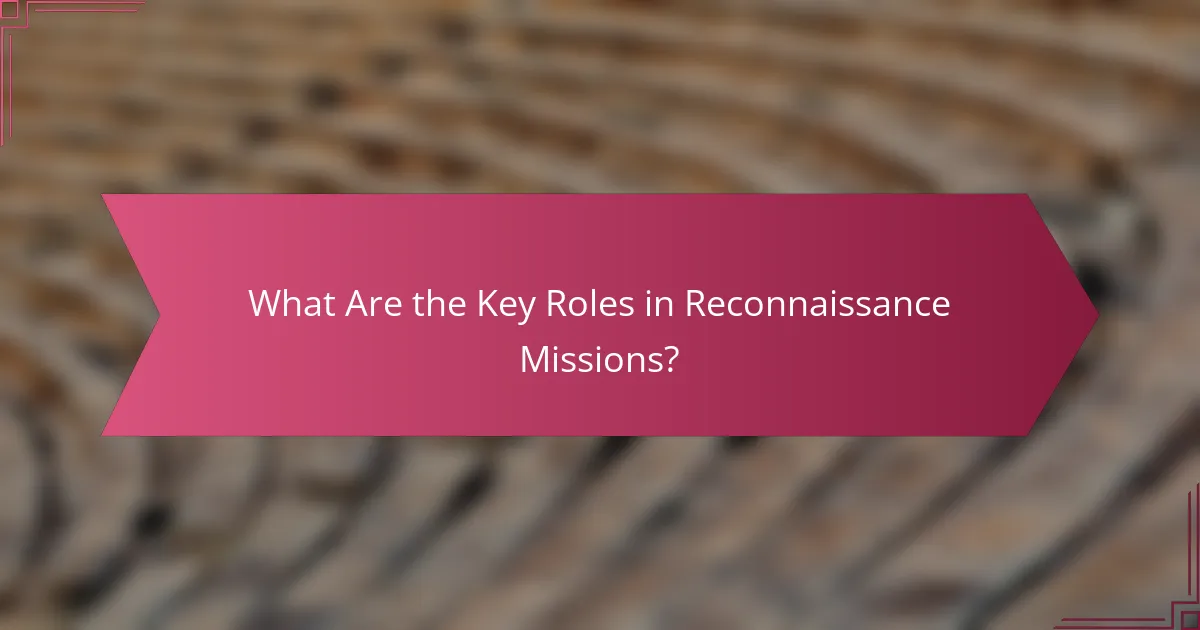Reconnaissance missions play a vital role in military operations by gathering essential information that ensures mission success. Utilizing various techniques such as Human Intelligence (HUMINT), Signals Intelligence (SIGINT), and Geospatial Intelligence (GEOINT), these missions provide unique insights that inform strategic decisions. The intelligence gathered is crucial for understanding the battlefield, assessing threats, and planning effective responses.

What Are the Key Roles in Reconnaissance Missions?
The key roles in reconnaissance missions are essential for gathering information and ensuring mission success. Each role contributes unique skills and expertise, facilitating effective planning and execution of operations.
Intelligence Officer
The intelligence officer is responsible for collecting, analyzing, and disseminating information relevant to reconnaissance missions. They assess threats, identify targets, and provide strategic insights to guide operational decisions.
Effective intelligence officers must stay updated on geopolitical developments and maintain strong networks for information gathering. They often use various sources, including satellite imagery, human intelligence, and open-source data.
Field Operative
Field operatives conduct on-the-ground reconnaissance, gathering real-time data about enemy positions and terrain. They are trained to navigate challenging environments and often work in small teams to minimize detection.
Successful field operatives need to possess skills in stealth, communication, and survival tactics. They often use specialized equipment, such as drones or surveillance cameras, to enhance their information-gathering capabilities.
Analyst
Analysts play a crucial role in interpreting the data collected during reconnaissance missions. They synthesize information from various sources to create comprehensive reports that inform decision-makers.
Analysts must be skilled in critical thinking and data visualization, often using software tools to present their findings clearly. They help identify patterns and trends that may not be immediately apparent from raw data.
Technical Specialist
Technical specialists provide expertise in specific technologies used during reconnaissance missions, such as surveillance systems, communication devices, and data analysis software. Their knowledge ensures that the latest tools are effectively integrated into operations.
These specialists often conduct training for other team members on how to use advanced equipment. They also troubleshoot technical issues that may arise during missions, ensuring smooth operations.
Support Personnel
Support personnel are essential for the logistical and administrative aspects of reconnaissance missions. They handle planning, coordination, and resource management, allowing field operatives and intelligence officers to focus on their tasks.
Roles in support can include transportation, supply chain management, and medical assistance. Effective support personnel ensure that missions are well-resourced and that all team members are prepared for deployment.

What Techniques Are Used in Reconnaissance Missions?
Reconnaissance missions utilize various techniques to gather information about an area or target. These methods include Human Intelligence (HUMINT), Signals Intelligence (SIGINT), Geospatial Intelligence (GEOINT), and Open Source Intelligence (OSINT), each serving distinct purposes and providing unique insights.
Human Intelligence (HUMINT)
Human Intelligence (HUMINT) involves collecting information through interpersonal interactions. This can include interviews, informants, and surveillance of individuals to gather insights about enemy plans or capabilities.
Effective HUMINT relies on building trust and rapport with sources, which can take time and effort. It is crucial to assess the reliability of the information obtained, as personal biases may influence the data.
Signals Intelligence (SIGINT)
Signals Intelligence (SIGINT) focuses on intercepting and analyzing electronic communications. This includes phone calls, emails, and other forms of digital communication to gather intelligence on enemy movements and strategies.
Utilizing advanced technology, SIGINT can provide real-time data, but it often requires legal permissions and adherence to regulations regarding privacy and surveillance. Analysts must be skilled in deciphering coded messages and understanding communication patterns.
Geospatial Intelligence (GEOINT)
Geospatial Intelligence (GEOINT) involves analyzing imagery and geospatial data to assess physical environments. This can include satellite images, aerial photography, and mapping technologies to identify terrain features and infrastructure.
GEOINT is particularly useful for planning operations, as it provides a visual representation of the battlefield. Analysts must be proficient in geographic information systems (GIS) and understand how to interpret various data layers effectively.
Open Source Intelligence (OSINT)
Open Source Intelligence (OSINT) refers to gathering information from publicly available sources. This can include news articles, social media, government reports, and academic publications to gain insights into potential threats or developments.
While OSINT is cost-effective and widely accessible, the challenge lies in verifying the credibility of the sources. Analysts should cross-reference information from multiple outlets to ensure accuracy and avoid misinformation.

How Do Reconnaissance Missions Provide Strategic Value?
Reconnaissance missions offer strategic value by gathering critical information that informs military and operational decisions. This intelligence helps in understanding the battlefield, assessing threats, and planning effective responses.
Threat Assessment
Threat assessment involves identifying and evaluating potential dangers to military operations. Reconnaissance missions collect data on enemy positions, capabilities, and movements, allowing commanders to gauge risks accurately.
For example, aerial reconnaissance can reveal troop concentrations or fortifications, which helps in determining whether to engage or withdraw. Regular updates from reconnaissance can shift threat levels, ensuring timely responses to emerging situations.
Operational Planning
Operational planning relies heavily on the insights gained from reconnaissance missions. By understanding the terrain, enemy strengths, and logistical challenges, military planners can devise strategies that maximize effectiveness while minimizing risks.
Reconnaissance data can inform decisions on troop deployments, supply routes, and timing of attacks. For instance, knowing the location of enemy defenses can lead to more effective flanking maneuvers or airstrikes.
Resource Allocation
Resource allocation is critical in ensuring that military assets are used efficiently. Reconnaissance missions help determine where to deploy resources, such as personnel, equipment, and funding, based on the assessed needs and threats.
For example, if reconnaissance indicates a high threat in a specific area, additional troops and equipment may be allocated there. Conversely, areas assessed as low risk can see a reduction in resources, allowing for better overall efficiency in military operations.

What Are the Prerequisites for Effective Reconnaissance Missions?
Effective reconnaissance missions require thorough preparation, including specialized training and the right technology. These elements ensure that personnel can gather accurate intelligence while minimizing risks and maximizing operational success.
Training Requirements
Personnel involved in reconnaissance missions must undergo rigorous training that covers various aspects of intelligence gathering, navigation, and situational awareness. Training often includes physical conditioning, survival skills, and the use of specific reconnaissance techniques tailored to the mission type.
Additionally, understanding the operational environment is crucial. This may involve language training, cultural awareness, and knowledge of local geography to enhance communication and effectiveness in the field.
Technology and Tools
Modern reconnaissance missions rely heavily on advanced technology and tools to collect and analyze data. Drones, satellite imagery, and surveillance systems are commonly used to provide real-time information and enhance situational awareness.
It is essential to select the right tools based on mission objectives. For instance, unmanned aerial vehicles (UAVs) can cover large areas quickly, while ground sensors may be more effective for detailed observations in specific locations. Regular updates and maintenance of these technologies are critical to ensure reliability during missions.

How to Choose the Right Techniques for Your Mission?
Selecting the appropriate techniques for reconnaissance missions hinges on the mission’s objectives, environment, and available resources. Consider factors such as the level of risk, the type of information needed, and the technological capabilities at your disposal.
Assessing Mission Objectives
Clearly defining mission objectives is crucial in determining the right techniques for reconnaissance. Are you gathering intelligence on enemy troop movements, assessing terrain, or monitoring communications? Each goal may require different methods, such as aerial surveillance, ground reconnaissance, or electronic intelligence.
For instance, if the objective is to monitor troop movements, aerial reconnaissance using drones may be most effective. Conversely, if the goal is to gather detailed information about a specific location, ground reconnaissance might be necessary.
Understanding the Operational Environment
The operational environment significantly influences the choice of reconnaissance techniques. Factors such as terrain, weather conditions, and enemy presence can dictate the feasibility and effectiveness of certain methods. For example, dense forests may limit aerial surveillance, making ground teams more viable.
Additionally, urban environments pose unique challenges, requiring techniques that blend in with civilian activities. In such cases, using unarmed drones or covert ground teams can help gather intelligence without drawing attention.
Evaluating Available Resources
Assessing available resources is essential when selecting reconnaissance techniques. This includes personnel, equipment, and budget constraints. High-tech solutions like satellite imagery or advanced drones can be costly, while traditional methods may be more budget-friendly but less effective in certain scenarios.
Consider the trade-offs between cost and capability. For example, if budget constraints limit the use of advanced technology, leveraging a network of informants or utilizing ground teams may provide valuable insights without significant expenditure.
